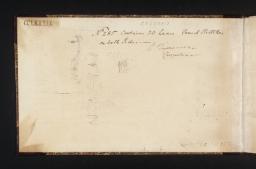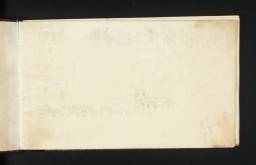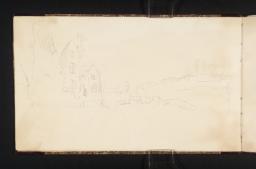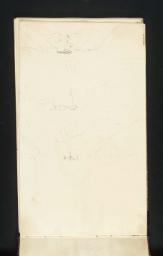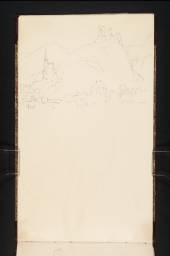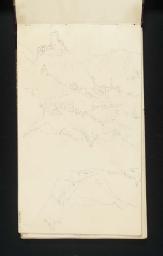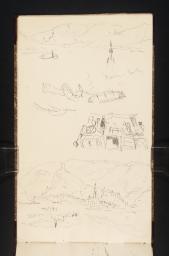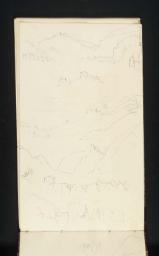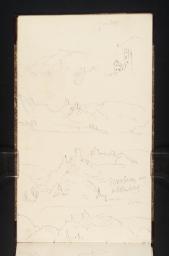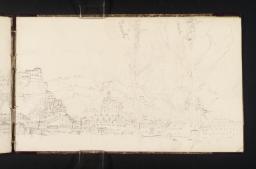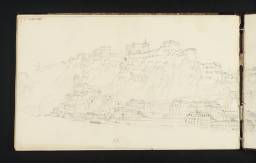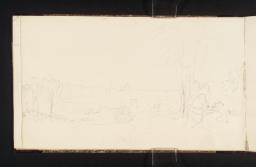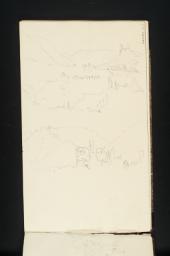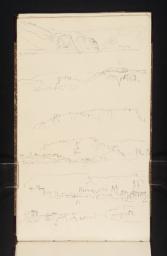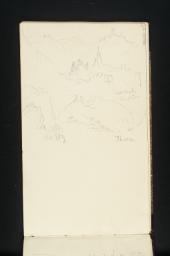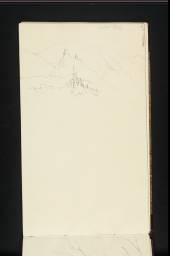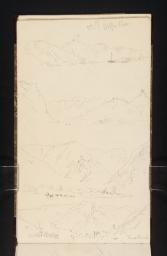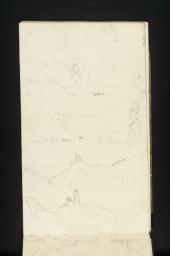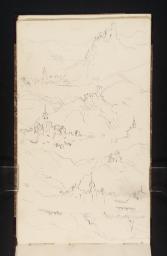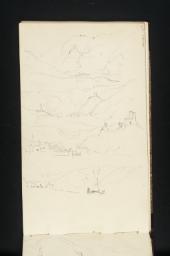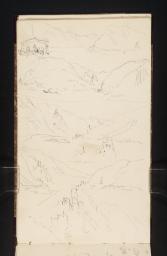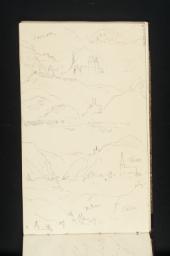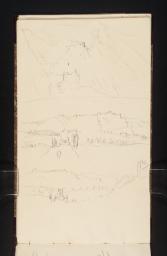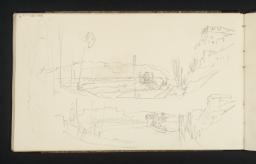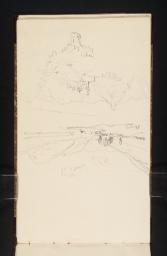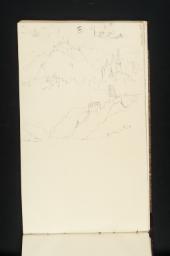Turner Bequest CCLXXXIX 1–30a
Sketchbook quarter-bound in boards covered in brown and white marbled white wove drawing paper with maroon leather spine and corners, each embellished with narrow gold lines
Inscribed in black ink by Turner with three short vertical lines on tail of text block
Signed by H.S. Trimmer and Charles Turner and inscribed in black ink ‘No 285 Contains 30 Leaves Pencil Sketches | on both sides–’ and signed in pencil by Charles Locke Eastlake ‘C.L.E.’ and by John Prescott Knight ‘JPK’ inside front cover paste-down
Blind-stamped with Turner Bequest monogram on leather spine of outside front cover and at centre of inside front cover paste-down
Stamped in black ‘CCLXXXIX’ at top right of outside front cover and at top left of inside front cover paste-down
Inscribed in pencil ‘CCLXXXIX’ at top centre towards right of inside front cover paste-down
Inscribed in pencil ‘A/O 27611–5 Jany 38–10’ inverted, bottom right inside front cover paste-down
30 leaves of white wove drawing paper
Watermark ‘j whatman, turkey mill, 1834’
Approximate size of page 140 x 235 mm
Inscribed in black ink by Turner with three short vertical lines on tail of text block
Signed by H.S. Trimmer and Charles Turner and inscribed in black ink ‘No 285 Contains 30 Leaves Pencil Sketches | on both sides–’ and signed in pencil by Charles Locke Eastlake ‘C.L.E.’ and by John Prescott Knight ‘JPK’ inside front cover paste-down
Blind-stamped with Turner Bequest monogram on leather spine of outside front cover and at centre of inside front cover paste-down
Stamped in black ‘CCLXXXIX’ at top right of outside front cover and at top left of inside front cover paste-down
Inscribed in pencil ‘CCLXXXIX’ at top centre towards right of inside front cover paste-down
Inscribed in pencil ‘A/O 27611–5 Jany 38–10’ inverted, bottom right inside front cover paste-down
30 leaves of white wove drawing paper
Watermark ‘j whatman, turkey mill, 1834’
Approximate size of page 140 x 235 mm
Accepted by the nation as part of the Turner Bequest 1856
Exhibition history
References
This is the third sketchbook of five used by Turner on his Meuse-Moselle (or Mosel, as it is known in Germany) tour of 1839. It is the anomaly of the group because the sketchbook is not of continental manufacture as the others are, and because the tour sketches are situated in the blank spaces between existing pencil studies of Oxford. These earlier Oxford drawings date from between 1834 to 1839.1 Turner must have brought this partially used sketchbook with him from England, perhaps because its horizontal format was conducive to recording wide panoramas. As it transpired, the artist did not use that page orientation on this leg of the tour, instead adopting his ‘customary expedient of using the pages as though they were of vertical format and dividing them up into small rectangular segments’ so as to record scenery of the Moselle quickly, as it changed before him.2
The book contains Turner’s first impressions of the Moselle River, which he descended by boat from the ancient Roman city of Trier. Most of the jottings are ‘flung helter-skelter into the nooks and crannies’ left by the Oxford sketches, ‘their lines often jerky and uncontrolled, their viewpoints consistently low and in mid-river’ with ‘sequences of sketches [showing] recognisable towns coming close and closer as Turner was carried downstream towards them’.3 Various settlements and castles are represented, ranging from those on the loops of the Moselle closest to Trier (like Trittenheim and Neumagen) to the confluence of Moselle and Rhine at Koblenz. Written annotations are rushed and often almost entirely illegible, indicating that the artist was on the move whilst recording what he saw. While the majority of the First Mossel and Oxford sketches are slight and summary, there is one striking exception. This is the double-page, full-sized, highly detailed and finely wrought study of the fortress of Ehrenbreitstein which lies across the river from Koblenz (Tate D28302–D28303; Turner Bequest CCLXXXIX 6a–7).
The city of Oxford itself is recorded in careful full-page and double-page topographical studies which were later to form the basis of a highly finished watercolour entitled Oxford from North Hinksey (1840).4 A handful of sketches show the nearby village of Iffley with its Norman Church of St Mary the Virgin.
How to cite
Alice Rylance-Watson, ‘First Mossel and Oxford Sketchbook 1839’, sketchbook, September 2013, in David Blayney Brown (ed.), J.M.W. Turner: Sketchbooks, Drawings and Watercolours, Tate Research Publication, November 2014, https://www

